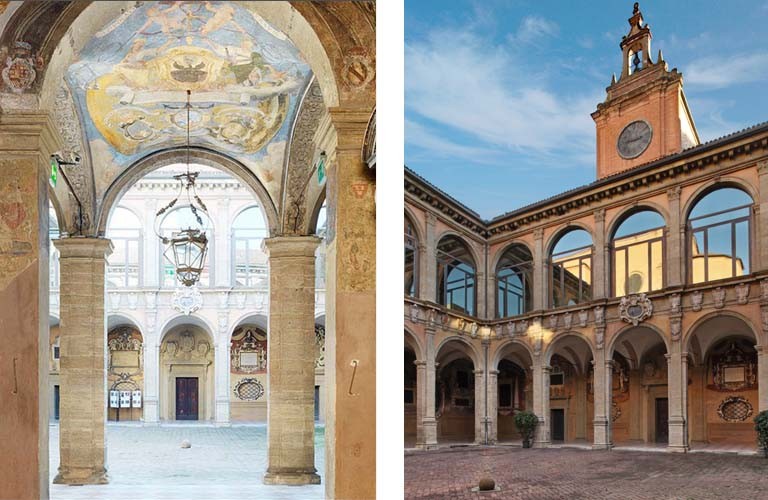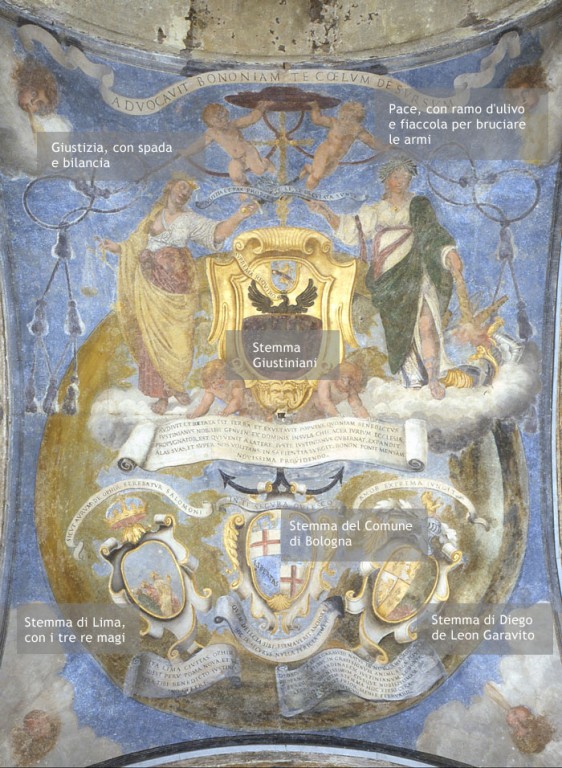The courtyard
The courtyard with a double arcaded loggia, the real fulcrum of the building, is influenced by the architecture of university boarding schools, of which that of Spain in Bologna is the prototype. It reminds the courtyards of the noble palaces of the city, where sumptuous ceremonies were held.

The courtyard was the scene of numerous events related to the history of Study: the most picturesque ceremony was the preparation of the Teriaca, a drug obtained by the combination of fifty elements, which served as a panacea against all ills and, in particular, against the bite of wild and poisonous animals.
Like every other room and wall of the building, the courtyard is adorned with sculpted or painted coats of arms and memorials. On the vault of the entrance, in a position of great importance, stands the fresco in honour of Cardinal Benedetto Giustiniani, which was dedicated to him by Diego de Leon Garavito, a Spanish student born in Lima, in Perù, who is considered the first "American" student to have attended the University of Bologna.
The "memorial" dedicated to Fornasari brothers (realised around 1678-1679) offers an example of the great variety of materials of which these monuments were made: in addition to the painted decorations, plaster, metal and sandstone were used too.
The double portrait of the Fornasari brothers overlooks the large allusive fresco which represents the two Legisti's justice and law activities.
A black and round globe, on which there is the commemorative inscription, appears surmounted by a sun (the sun of Justice), whose rays are partly covered by an oval metal slab on which the faces of the two Fornasari brothers are painted in oil colours (the double portrait is attributable to Lorenzo Bergonzoni). The Sun of Justice appears in the sign of Gemini, in the allusive and baroque symbolic language. The black globe, the fulcrum of the composition which is placed between the lintel of the door and the vault above, is surrounded by a fresco with various symbolic figures, realised by the famous Bolognese painter Giovanni Antonio Burrini.
Below, a stretched woman represents Justice with the breasts uncovered and a sword; on the left one of the two Dioscuri, the boxer Pollux, raises a child, identifiable with Lucifer, the morning star. On the right, the horse tamer Castor holds another child, Hesperus, the evening star, represented while covering his head.
The complex allegorical representation alludes to the fact that the first of the two brothers was the primary "de mane" lector and the other one was the ordinary "de sero" lector, so that the Sun of Justice, being in the middle between the morning (Lucifer) and the evening (Hesperus), was always in the astrological sign of Gemini (the Dioscuri Castor and Pollux allude to the Fornasari brothers): "Lucifero medius et Hespero stet Sol Iustitiae semper in Geminis". The fresco, realised by Giovanni Antonio Burrini, is a significant expression of the symbolism of Baroque figurative culture.

Affresco in onore del cardinale Benedetto Giustiniani, dedicatogli da Diego de Leon Garavito.

Memoria dedicata ai fratelli Fornasari

Acquerello di Domenico Ramponi, 1818
